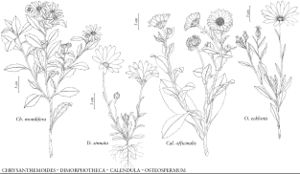Dimorphotheca
Methodus, 585. 1794.
| Taxon | Illustrator ⠉ | |
|---|---|---|
 | Chrysanthemoides monilifera Dimorphotheca sinuata Calendula officinalis Osteospermum ecklonis | Yevonn Wilson-Ramsey Yevonn Wilson-Ramsey Yevonn Wilson-Ramsey Yevonn Wilson-Ramsey |
Annuals [perennials, subshrubs, shrubs], 5–40 [150+] cm. Stems procumbent to erect [prostrate], glabrous or arachnose to piloso-hirtellous and/or stipitate-glandular. Leaves ± sessile or petiolate; blades oblong or oblanceolate to linear, margins entire or dentate [pinnately lobed], faces sparsely arachnose and/or stipitate-glandular. Heads borne singly. Involucres campanulate to hemispheric or broader, 5–20+ mm diam. Phyllaries 15–21 in 2 (–3) series, lanceolate to lance-linear. Receptacles flat to conic. Ray-florets 10–21+ in ± 1 series; corollas usually yellow to orange or white, sometimes purplish abaxially and/or at bases or apices, laminae oblongelliptic to oblanceolate. Disc-florets 15–50+, bisexual, all or mostly fertile (inner sometimes functionally staminate); corollas whitish or yellow, red, or purplish, tubes much shorter than ± campanulate throats (lobes sometimes with terete or dilated appendages). Cypselae (ray) triquetrous-prismatic to clavate, ± tuberculate or ridged; (disc) compressed, often winged, ± smooth. x = 9.
Distribution
Introduced; s Africa
Discussion
Species 7–18+ (2 in the flora).
Selected References
None.
Lower Taxa
Key
| 1 | Ray corollas mostly yellow to orange adaxially | Dimorphotheca sinuata |
| 1 | Ray corollas mostly whitish adaxially | Dimorphotheca pluvialis |
"broader" is not a number.